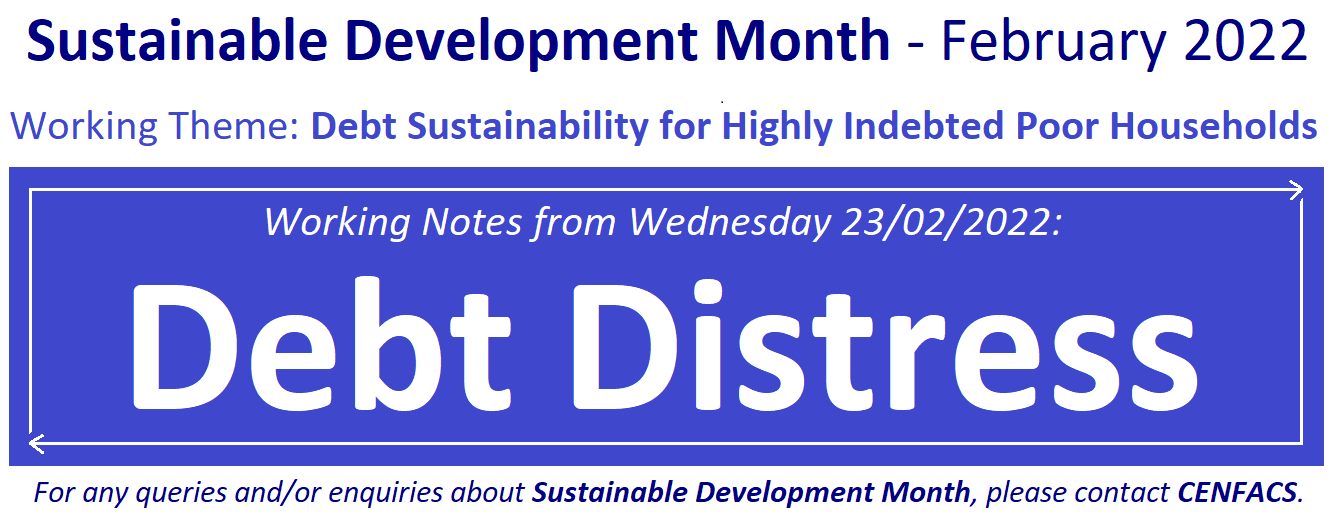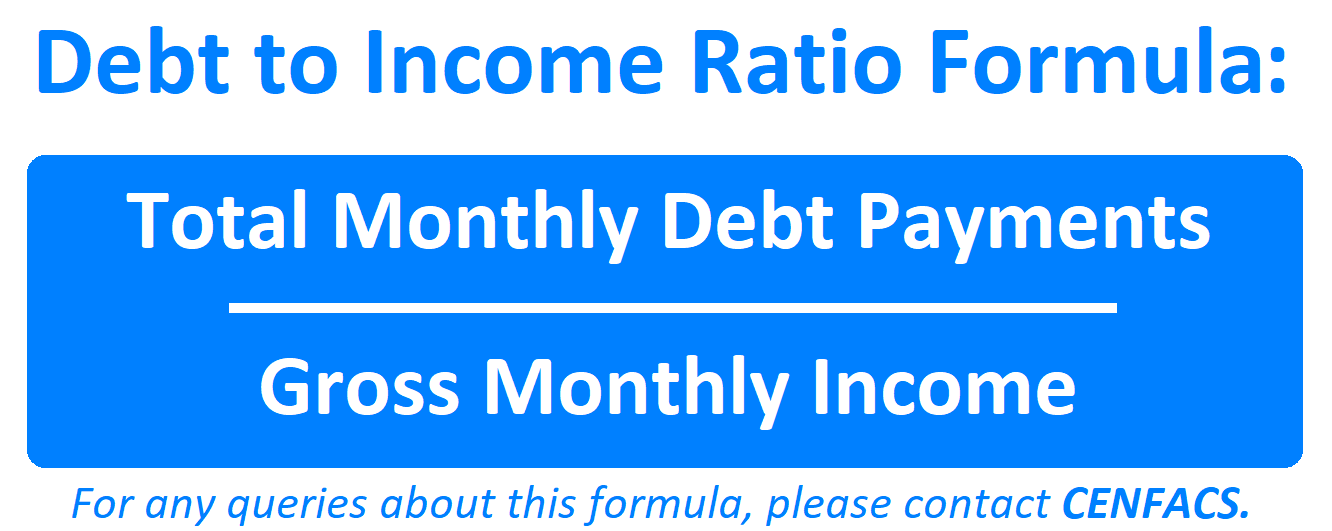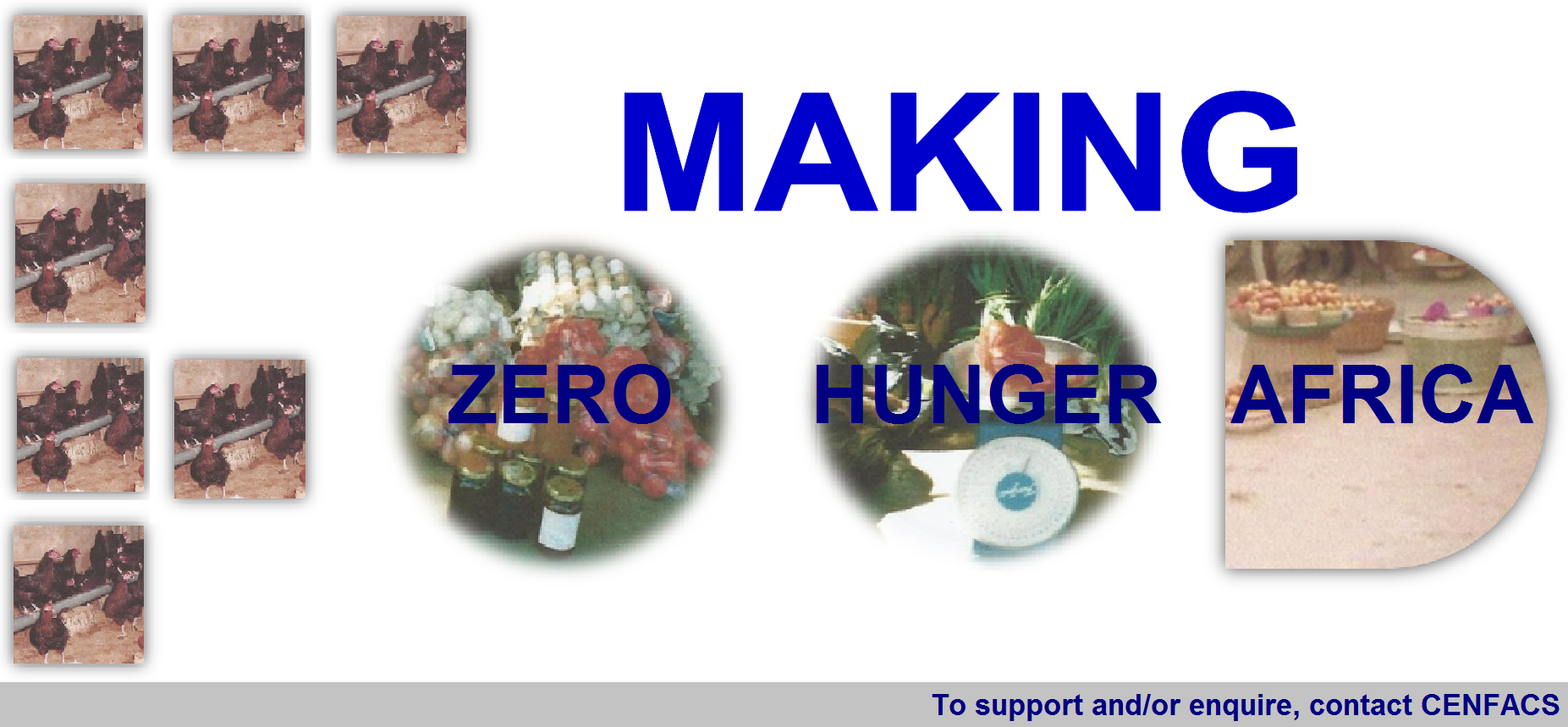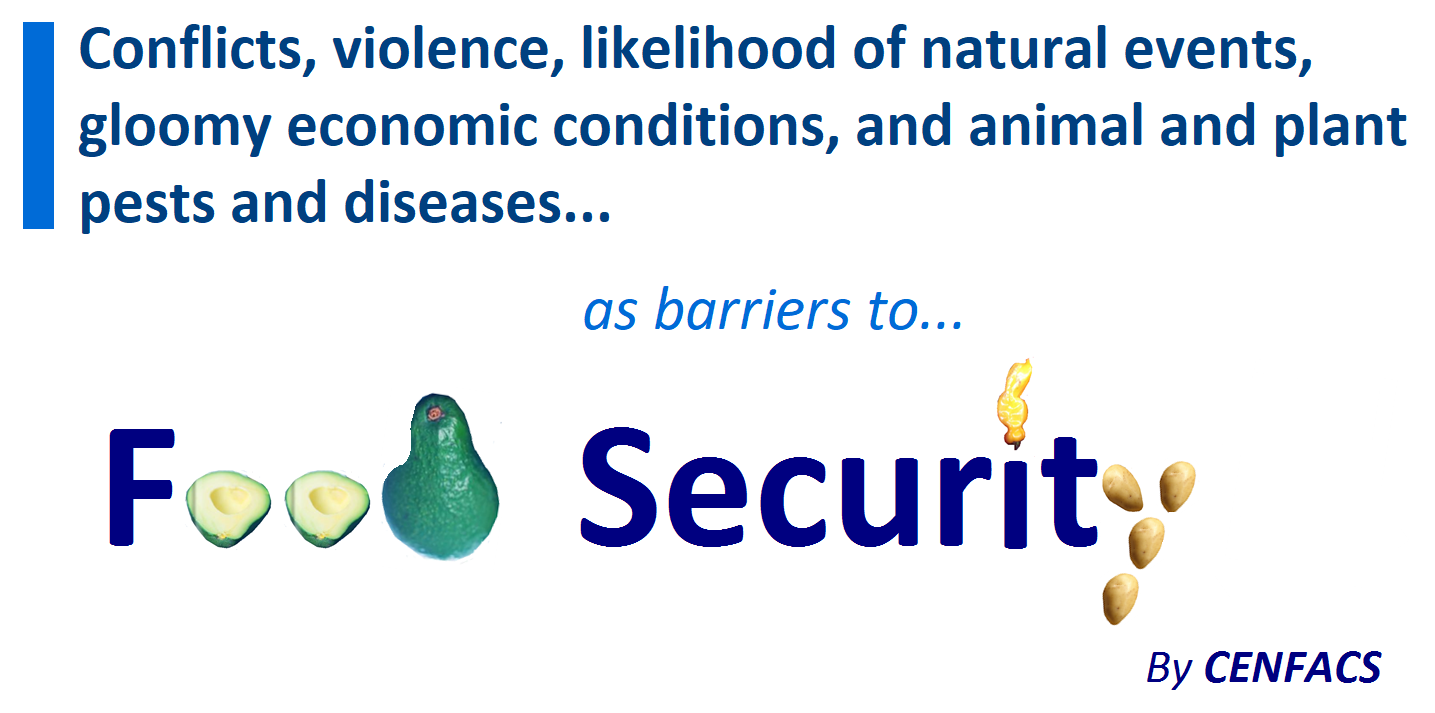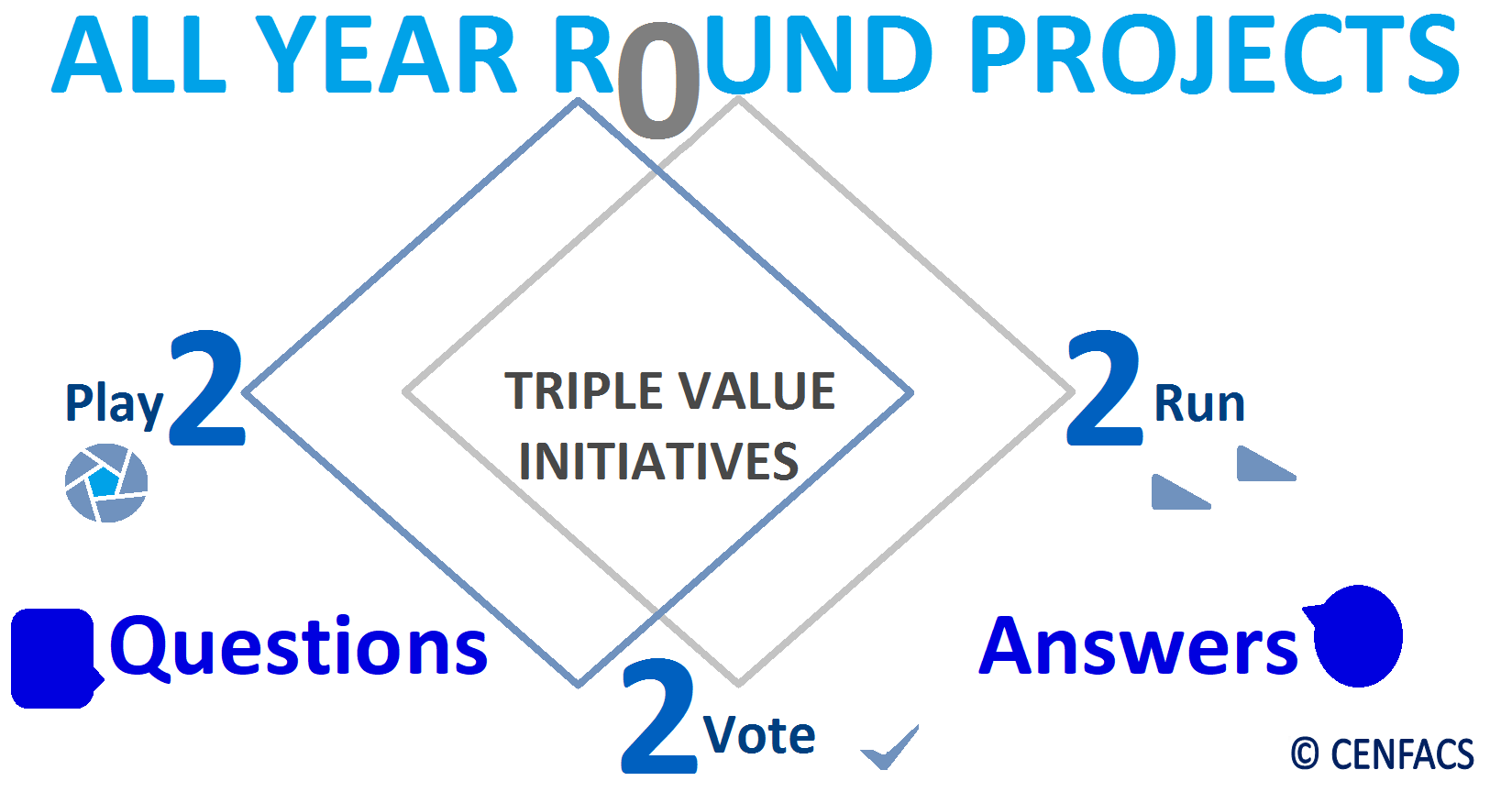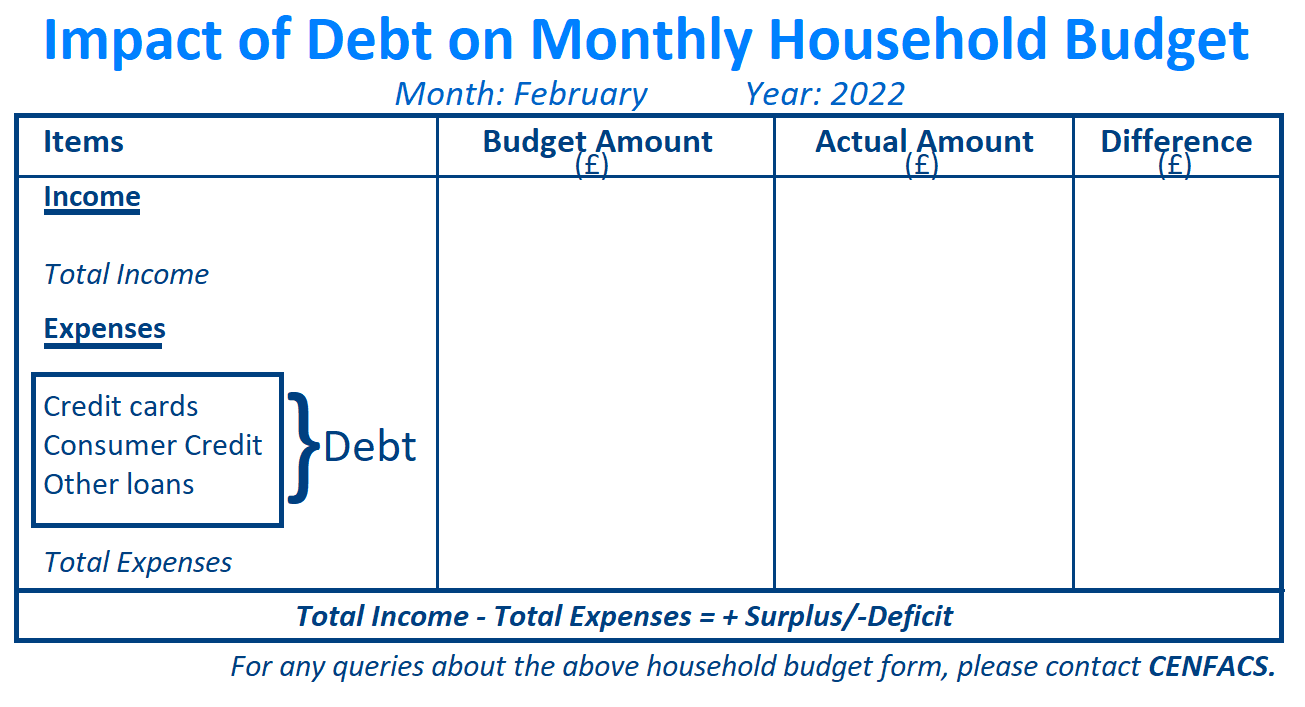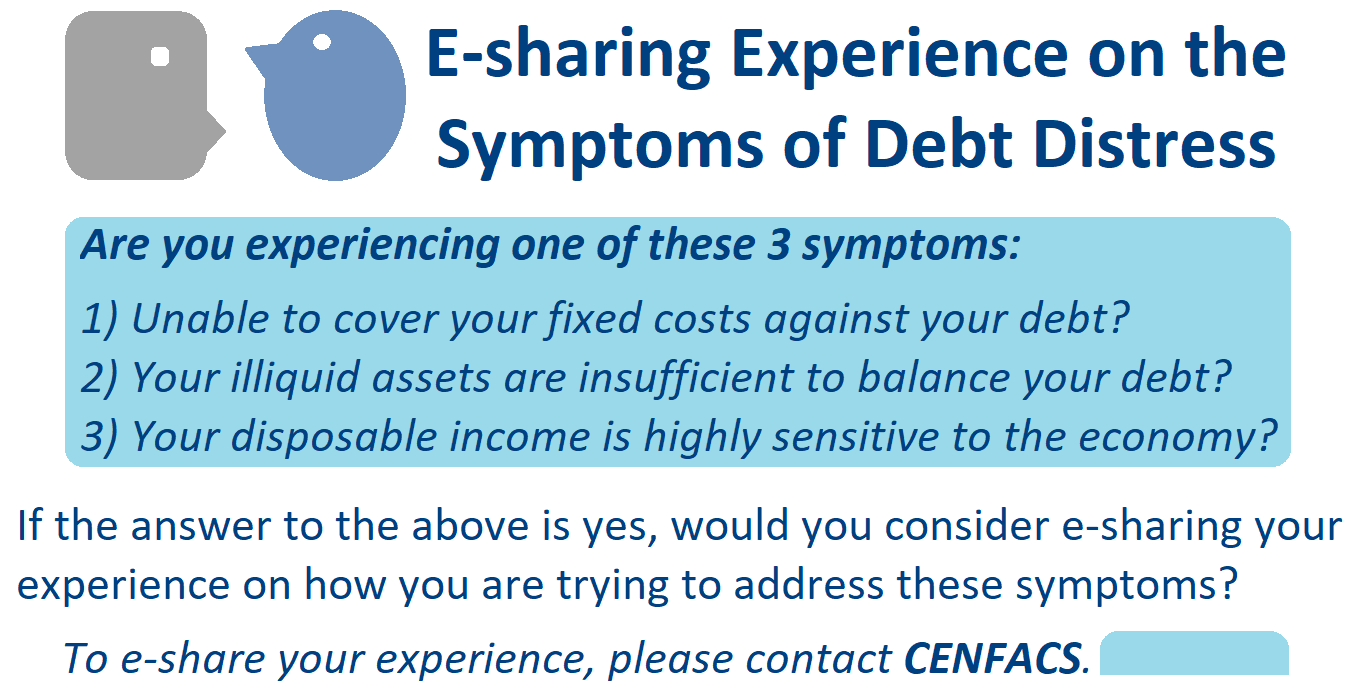Welcome to CENFACS’ Online Diary!
23 February 2022
Post No. 236
The Week’s Contents
• Debt Distress for the Highly Indebted Poor Households
• Climate Neutral Projects
• Making Zero Hunger Africa Campaign with a Focus on Events Leading to Acute Food Insecurity
… And much more!
Key Messages
• Fourth Wednesday (23/02/2022), In Focus: Debt Distress for the Highly Indebted Poor Households
Our Month of Sustainable Development carries on with the last sub-theme making the theme of Debt Sustainability for the Highly Indebted Poor Households; theme which is part of the United Nations (1) Sustainable Development Goal 17 and Target 4 for poor countries. The last sub-theme is about Debt Distress for the Highly Indebted Poor Countries (HIPHs). Although the United Nations speak about Debt Distress in its Target 4 for poor countries, these notes are really about Debt Distress Free for the Highly Indebted Poor Countries. Having said that, what is debt distress?
Debt distress is one of the four ratings for assessing the risk of external public debt associated with sustainability, according to the International Monetary Fund (IMF). The IMF (2) argues that a country is in debt distress…
“When the country is already experiencing difficulties in servicing its debt, as evidenced, for example, by the existence of arrears, ongoing or impending debt restructuring, or indications of a high probability of a future debt distress event (e.g., debt and debt service indicators show large near-term breaches, or significant or sustained breach of thresholds).”
Debt distress matters not only for countries but also for households and individuals making indebted countries. For highly indebted poor households, debt distress could simply mean that they are in a financial situation in which they have so much debt or high level of debt compared to their both tangible and intangible assets. This troubled financial situation can prevent them from functioning as a normal household while it can sometimes lead to debt-induced poverty. This is why something needs to be done in terms of reduction of debt distress and risks associated with it in order to enable debt distressed households not to totally and humanly collapse.
So, the key message here is about helping HIPHs to both come out debt-induced poverty and moral poverty as they are experiencing debt distress. In other words, the effort here is about making sure that debt distress does not lead to moral distress which could be another form of poverty that may require debt advice and counselling. Debt distress, which is already a financial difficulty and hardship as well as a form of poverty, should not lead to another type of poverty, like mental and emotional one.
For an insightful outlook about the sub-theme of Debt Distress for the Highly Indebted Poor Countries, please read under the Main Development section of this post.
• Climate Neutral Projects (CNPs)
The following items summarise CNPs: What are CNPs?, their components, how CENFACS can work with users so that the latter can get the most from CNPs and the link between climate neutrality and poverty reduction.
• • What are CNPs?
In its guide to climate neutrality, the United Nations Framework Convention on Climate Change (3) defines climate neutrality as
“The idea of achieving net zero greenhouse gas emissions by balancing those emissions so they are equal (or less than) the emissions that get removed through the planet’s natural absorption; in basic terms it means we reduce our emissions through climate action”.
With reference to the above perspective on climate neutrality, we can argue that CNPs, which are one of CENFACS’ Light Season’s new initiative, are about putting into practice the idea of achieving net zero greenhouse emissions by balancing those emissions so that they are equal (or less than) the emissions that get removed through the planet’s natural absorption capacity. In simple terms, CNPs help to reduce our emissions through climate action.
There is a number of initiatives on which CENFACS will be working with users under the banner of CNPs.
• • CNP Components
They are initiatives or activities that CNP users can undertake anywhere (at home, at work and on the move). These greenhouse gas emission reduction or removal initiatives or activities can include:
√ Walking or cycling
√ Switching to LED bulbs and green electricity
√ Turning off tap when brushing your teeth
√ Using natural light as much as possible
√ Only registering on mailing lists if it is important to do so
√ Reducing junk mail
√ Using energy-efficient electric devices
√ Switching to paperless life (e.g. use your device like phones, laptops, tablets, etc., to manage your financial operations)
Etc.
These activities or initiatives will help to measure our user households’ CO2 emissions. Alternatively, user households can use online climate change calculator to determine the emissions (direct emissions like combustion and indirect emissions) that arise in their households through heating, cooking, and so on.
• • How CENFACS can work with users on CNPs
There are basically two ways through which CENFACS can work together with users, which are:
a) sharing experience about initiatives taken to avoid climate-damaging greenhouse gas emissions
b) accompanying those who would like to take a climate neutral path.
a) Experience sharing about climate neutrality
So far, so much has been written and said about climate neutrality. There are already people, including those making our community, who are already using these writings and says in their daily lives – whether it is at home or at work or even when travelling – in the choice they make in order to run their lives. For those ones, they can share with us their good practice of climate neutrality experience or initiatives. This experience sharing will also be part of monitoring and evaluation of CNPs.
b) Accompany to a climate neutral path
For those who would like or may be interested in taking a climate neutral drive, but for some reasons they are not doing it; they can work with CENFACS so that together we can explore ways of taking climate neutral action with them. We can help them with tips and hints as well as we can support them to find what is required for them to find their way to climate neutral road.
• • Climate neutrality and poverty reduction
CNPs are also poverty reduction initiatives. By taking action to bring down one’s own CO2 emissions to zero, this action can also help to reduce poverty, especially for those looking for climate neutrality-based solutions to poverty.
For example, if you are poor and take some initiatives to switch off lights and move to green electricity; this action can help to save on both electricity bills and income.
So, taking some steps to reduce unnecessary consumption in terms of climate neutrality can benefit those living in poverty by reducing the cost of running their lives. And, if they can get the same level of satisfaction with goods and services (like electricity, gas, water, etc.) by reducing the costs of these goods and services; the unspent money can be allocated to other needs.
This action can help them to reduce income poverty. Indeed, if you are income poor, any tiny reduction you can get or save on your expenses could be a huge boost for you. It may not be something for well-off people, but for the poor it can make a lot of helpful difference.
For those members of our community who have personal experience to share about climate neutrality and/or those who would like to dip into climate neutrality with us, they are welcome to contact CENFACS.
• Making Zero Hunger Africa Campaign with a Focus on Events Leading to Acute Food Insecurity
This year’s Making Zero Hunger Africa Campaign (MZHAC) will focus on events or key drivers that can lead to acute food insecurity in Africa, especially in the so-called Africa’s hunger hotspots. Before looking at what is in focus, let us remind our readers the aim of Making Zero Hunger Africa Campaign.
• • Aim of Making Zero Hunger Africa Campaign
The aim of MZHAC is to raise awareness on sustainable food consumption and production in order to end hunger and malnutrition amongst those who are food deprived, particularly in Africa where the number of hungry people and families is still on the rise. It is as well a campaigning response to the challenge of rise in hunger that Africa will face in the foreseeable future. In this respect, the coronavirus pandemic has only made the matter worse as it has put a heavy toll on the consumption poor.
The contents of MZHAC are: End Hunger and Malnutrition Goal, Support Small-Scale Food Producers in Africa, Actions to Support the Food Industry in Africa, Meeting Vulnerable People’s Nutritional Needs, Actions for Sustainable Food Production Systems, etc.
This year, we are focussing on Events Leading to Acute Food Insecurity.
• • Focus on Events Leading to Acute Food Insecurity
To help our readers and audiences to understand what we are talking about and possibly follow our campaign, let us explain acute food insecurity.
• • • What is acute food insecurity?
The Food and Agriculture Organisation of the United Nations and the World Food Programme (4) define acute food insecurity as
“Any manifestation of food deprivation that threatens lives or livelihoods regardless of the causes”. (p. 37)
In their joint publication entitled ‘Hunger Hotspots’, the two organisations give their warnings on acute food insecurity in Africa’s hunger hotspots.
Following on these warnings and findings about Africa’s hunger hot spots, we have framed our MZHAC around four events or areas of action that may influence food security in Africa and that need to be seriously taken in order to make zero hunger Africa. The four events or areas are: violence and conflict, natural events, adverse economic factors, and pests and diseases from fauna and flora. Let us look at these drivers or influencers one by one.
• • • Drivers or influencers of acute food insecurity in Africa
• • • • Violence and conflict
To respond to this driver, MZHAC will be about CENFACS working with Africa-based Sister organisations (ASOs) to help people displaced by violence to access food, agricultural land and other life-sustaining livelihoods.
• • • • Likelihood of natural events
MZHAC will be activated to work with ASOs to support vulnerable households to replenish their food stocks in the event of poor season and poor harvests leading to the worsening of food insecurity conditions, like in the Greater Horn of Africa.
• • • • Adverse economic conditions
MZHAC will be stepped up to work with ASOs to help those in need to overcome barriers to access food and various economic difficulties such as soaring food price, disruption of food supply chains, increase in energy prices, etc.
• • • • Pests and diseases from animals and plants
MZHAC will be conducted with ASOs to assist in the fight against the problems of current upsurge of the widespread migratory pest and swarm formation, like in the case of desert locust upsurge in Greater Eastern Africa.
So, the message of the MZHAC for this year is to help avert acute food insecurity and malnutrition. To do that one needs removing barriers that can hamper any access to food. The message is finally about saving lives while preventing starvation and total collapse of livelihoods.
To support and or enquire about MZHAC, please contact CENFACS.
Extra Messages
• EcoBio Days: 24 to 28 February 2022
EcoBio (Ecological and biological) Days, which will be held from 24 to 28 February 2022, bring a climax to our Sustainable Development month.
• • What EcoBio Days are about?
EcoBio Days are the days of works about the nexus between organisms (e.g. animals, plants, etc.) and their environment.
They are as well the days of study about living organisms.
The days are about how we deal with living things and their environment in order to meet our own needs and goals without compromising the ability of future generations to meet theirs.
They are the days of humans with their environment as well as humans with things and living organisms.
• • Programme for this year’s EcoBio Days
The programme for this year’s EcoBio Days is as follows:
24/02/2022: Link between organisms and their environment
25/02/2022: Study of living organisms and poverty reduction
26/02/2022: Humans with things
27/02/2022: Humans with living organisms
28/02/2022: Humans with their environment
To enquire and or support EcoBio Days, please contact CENFACS.
• Triple Value Initiatives: Questions (Q) and Answers (A) for Starters
We are pursuing the planning process for Triple Value Initiatives (All Year Round Projects) by inviting those who may have some questions to raise and put them to CENFACS. CENFACS will try to respond to them.
To kick-start this invitation and clear some of the misconceptions about Triple Value Initiatives (All Year Round Projects), we are going to respond to the following questions.
Q • • What are Triple Value Initiatives or All-year Round Projects?
A • • They are a set of 3 yearly projects that run from the 1st week of January to the week preceding the end of last week of December of the same year. Through these 3 initiatives/projects (i.e. Run, Play and Vote), their users have the opportunity to do something about poverty reduction and sustainable development in the forms of either undertaking a physical activity (Run) or gaming activity (Play) or research activity (Vote). The participants to these projects can chose to engage with one of these projects/activities.
For those who want to organise a run activity or play the CENFACS’ League of Poverty Reduction or vote a person who made difference in helping others in reducing poverty in Africa; they can contact CENFACS if they have any problems about how they would like to engage with any of these activities.
Q • • What are the objectives of Triple Value Initiatives or All Year Round Projects?
A • • Each of the initiatives/projects has its own objectives. However, we can broadly argue that their objectives include the following:
σ To recognise and acknowledge those who are helping to reduce poverty and enhance sustainable development in Africa
σ To contribute to the efforts of poverty reduction in Africa
σ To celebrate and jointly promote sporting talents and sustainable skills in Africa
σ To honour outstanding individuals in the field of international poverty reduction and sustainable development
σ To game and provide recreational activities to a generation of gamers to do something different about poverty reduction and sustainable development in Africa.
Q • • How can I participate?
A • • Anyone can participate or run any of these projects as long as they follow the underlying principles relating to them. They can use whatever means are necessary and available to undertake and complete these projects.
For example, if one wants to undertake physical run, they need to plan the running equipment they need including personal protection equipment against the coronavirus; to have a devise to time themselves, a bottle of water, a pair of comfortable trainers, etc.
Q • • When can I enter these projects?
A • • You can enter any of these projects at any time of the year. However, since they are all year round projects, it is better to join or run them early. This way, you will have more time to organise yourself and fit them within your priorities and other areas of life. Also, if you start earlier it is much easier to get help than if you start later.
Q • • Why should I run these projects?
A • • There are several reasons that may help you to decide to participate like the following:
√ These projects may help you to improve your own life in terms of physical and mental health, wellbeing, fitness and happiness
√ You can use them as a way of bringing back something to the community
√ You can take the opportunity given through these projects to do something against poverty and hardships
√ You can use them to improve sustainable development and reduce adverse impact of climate change on any lives
For example, during the coronavirus crisis and lockdowns, some used them to break out the vicious circle of the COVID-19 lockdown pressure.
Q • • Where can I run them?
A • • It depends on each of the projects.
For run activity, you can do it outdoor and or indoor.
As to gaming activity, you can play online or offline.
Concerning vote activity, you obviously need to conduct some background research which you can do at home, in the library, online or travel abroad for those who can. You can as well do fieldwork.
It really depends on your ambition and what you want to achieve as outcomes.
So, the above are the possible questions and related answers for those who would like to know more about Triple Value Initiatives (All Year Round Projects).
For those who have still questions to ask, they can address them to CENFACS.
• Zero Income Deficit Campaign: The Impact of Debt on Household Budget
As part of Zero Income Deficit Campaign, we are working on the impact of debts on household budget, in particular how the payments of both principal and interest as scheduled in the debt contract can impact household budgets.
Through this work, we hope to undertake the following:
√ Look at household budget constraint linked to debts, particularly the elements like available assets, the liquidity of those assets and structure of debt
√ Explore ways with users on how to deal with these monthly fixed expenses linked to debt payments
√ Find out whether or not honouring debt payments becomes distressing or is putting a stress on other budget items
√ Identify distressed items within household budgets and find ways of addressing them with users.
This work will help households with budget negatively affected by debt to find ways of maintaining their basic life-sustaining consumption without going into negative net worth and debt distress. The work will include any budgetary period (that is, monthly or quarterly or six-monthly or yearly period).
For those members of our community who would like to work on the impact of debt on their household budget, they are free to contact us.
Need to work with us on the impact of debt payments on your household budget, please contact CENFACS.
Les Journées EcoBio (Écologiques et Biologiques) qui se tiendront du 24 au 28 février 2022 marquent le point culminant de notre mois du Développement Durable.
En quoi consistent les Journées EcoBio ?
Les Journées EcoBio sont les jours de travail sur le lien entre les organismes (par exemple, les animaux, les plantes, etc.) et leur environnement.
Ce sont aussi les jours d’étude sur les organismes vivants.
Les journées portent sur la façon dont nous traitons les êtres vivants et leur environnement afin de répondre à nos propres besoins et objectifs sans compromettre la capacité des générations futures à répondre aux leurs.
Ce sont les jours des humains avec leur environnement ainsi que des humains avec les choses et les organismes vivants.
Quel est le programme de ces Journées EcoBio?
Au menu du programme de ces Journées EcoBio, nous avons choisi les sous-thèmes suivants:
24/02/2022: Lien entre organismes et leur environnement
25/02/2022: La biologie et la réduction de la pauvreté
26/02/2022: Les humains avec des choses
27/02/2022: Les humains avec des organismes vivants
28/02/2022: Les humains avec leur environnement
Pour vous renseigner et/ou soutenir les Journées EcoBio, veuillez contacter le CENFACS.
Main Development
• Fourth Wednesday (23/02/2022), In Focus: Debt Distress for the Highly Indebted Poor Households
To enable us to effectively work with beneficiaries on the theme of Debt Sustainability for the Highly Indebted Poor Households, we have composed the notes relating to Debt Distress as follows:
Understanding of debt distress, signs of debt distress, causes of debt distress, remedies to debt distress, costs of debt distress, and CENFACS’ role in working with HIPHs to reduce debt-induced poverty.
Let us go through each of these composed notes.
• • Understanding of debt distress
Our understanding of debt distress in this post should be placed within the context of HIPHs, since we are not dealing with countries. We are working with people who make countries. In this context, a HIPH is in debt distress if the HIPH is unable to fulfil its financial obligations towards its creditors because of financial difficulty or hardship. There are or could some indication or indicators displaying that a given HIPH is in debt distress or financially troubled.
• • Signs or indicators of debt distress
The following can tell if a particular HIPH is in debt distress or debt-distressed:
∝ The HIPH has unmanageable debt
∝ The HIPH has cash flow problems if its cash flow statement or projection is often in deficit without any hopes of improvement
∝ The HIPH is defaulting on debt payments at recurring grounds
∝ The HIPH is asking for or often in need of extended debt repayment terms or plan
∝ The HIPH is constantly struggling to make ends meet, particularly to cover its living expenses (e.g. household utility bill arrears) unless it depends on debt
∝ The HIPH has lost moral and is experiencing or on the brink of mental or emotional or physical pain because of debt pressure
∝ The HIPH’s debt cannot be covered by its fixed or illiquid assets
∝ The HIPH’s disposable income is highly sensitive to the economic trends.
Many of these signs or indicators can be found in debt-distressed households. These signs do not come by themselves. They have origins.
• • Causes of debt distress
The literature survey on the origins of debt distress for poor households suggests that there are many reasons for which households can end up in debt distress. Amongst the causes are the following:
∝ Lack of knowledge about the mechanics of debt, especially of the interest rate
∝ Lack of monitoring activity between debt servicing costs and monthly income, between cash inflows and cash outflows
∝ Income poverty
∝ Poor budgeting and forecasting
∝ Insufficiency and loss of earning capacity
∝ Debt load
∝ Lawsuit
Etc.
Amongst the above stated causes, we would like to concentrate on the lack of knowledge about the mechanics of debt and of the interest rate.
• • • Lack of knowledge about the mechanics debt and changes in interest rates
Some of the HIPHs do not understand how the mechanics of debt runs and how creditors work out their interest rates (both simple and accrued interests or fixed and flexible). They do not also comprehend the difference between the principal and interest as well as how economic crises can impact, particularly inflate, debt payments while constraining incomes. Failure to understand these parameters (i.e., fluctuations in interest rate, inflation, soaring prices, currency exchange rates, debt contracts, income constraints, etc.) may not help them.
Other HIPHs could grasp these parameters. Yet, when these parameters change a little in a such way that they do not favour them; they could be in serious trouble since their disposable income could be highly sensitive to these parameters. This situation could easily lead them to debt distress; that is in dire need of help.
However, being in debt distress is not an automatic end of life if there is remedy to the problem or help somewhere.
• • Remedies to debt distress
There are classic remedies to debt distress which include initiatives such as credit counselling and advice, renegotiation of debt obligations, cutting back unnecessary or excessive spending habits, debt consolidation, etc.
Except credit counselling and advice and debt renegotiation, many of these classic answers may not be applicable to HIPHs. They may not be suitable to them because we are talking about people who are poor and without collaterals to cover their debts/owings. Many of these debt-distressed households would rather prefer debt cancellation or forgiveness to stop them having continuing distress and be able start again their lives as debtless. Continuing debt distress is a cost for these financially troubled households.
• • Costs of debt distress
Debt distress is most acute amongst lower income and highly indebted poor households. It disproportionally affect the poor because not only they are unable to meet their financial obligations to their creditors, but also they do not have means to find an alternative to the problem. It costs them financially, psychologically, mentally, physically and emotionally.
In 2016 for example, the Citizens Advice Bureau (5) commissioned the Understanding Society Policy Unit at the Institute for Social and Economic Research (Policy Unit) to conduct new analysis of the Understanding Society survey regarding the impact of debt. The Citizens Advice Bureau argued from the findings of that study the following:
“The analysis found that there was a statistically significant positive relationship between high levels of personal debt and poor mental health, no statistically significant relationship between debt and low pay or poor physical health and a negative relationship between unmanageable debt and unemployment”.
Within households where there are children, these costs of debt distress could be even immense and incalculable as debt distress could negatively impact relationships within households, let alone it can jeopardise children’s education, welfare and well-being. Children from debt-distressed households can be affected by the mood of their households.
In this respect, debt distress can have generational effect in terms of the kind of poverty it can come with or lead to. Mental and emotional poverty takes time to heal since we are not only talking about poverty being a material lack, but also immaterial hardships. Working with debt-distressed poor households can help to mitigate some of these problems even if it may not help to heal most of them.
• • CENFACS’ role in working with HIPHs to reduce debt-induced poverty
As we mentioned it in the preceding notes to these ones, CENFACS‘ role in working with HIPHs is not to reduce or end debts. Our role is to help reduce debt-induced poverty.
In the context of this sub-theme of Debt Distress for HIPHs, it is about working together with them in order to help them navigate their way out poverty linked to debt distress. Through our work with them, we can undertake the following services:
√ Support them to become debt-distress free by setting up a debt-distress resolving strategy
√ Help better manage distressed household assets on their balance sheets
√ Provide them with leads to agencies/organisations dealing with debt distress as far as finances are concerned
√ Explore together ways of reducing the costs of debt distress on them.
Etc.
As a result of services provided against debt distress to the HIPHs, we hope to achieve the following together with them:
√ HIPHs will become sustainable (that is; having to maintain their basic life-sustaining consumption without going into negative net worth or debt distress)
√ Debt distress, which is already a financial difficulty and hardship as well as a form of poverty, will not transform itself into another type of poverty like mental, emotional or other one for HIPHs, especially for those at high risk of debt distress
√ Long-lasting debt distress, that can have far-reaching negative ramifications in terms of health and the economy of these households including intergenerational poverty, can be avoided.
Finally, we would like to end these notes to Debt Sustainability and Distress for HIPHs by highlighting what the World Bank (6) has recently argued for COVID-induced debt and debtors in her World Development Report 2022, which is:
“The law and the courts should aim to quickly resolve no-income, no-asset cases and provide a discharge and fresh start for all natural person debtors“. (p. 141)
For those members of our community who are debt-induced poor and who would like to discuss their debt-induced poverty problems, they are welcome to contact CENFACS.
For any other queries and enquiries about CENFACS‘ Month of Sustainable Development, the theme of Debt Sustainability and the sub-theme of Debt Distress for the Highly Indebted Poor Households; please do not hesitate to contact CENFACS.
_________
• References
(1) https://sdgs.un.org (accessed in February 2022)
(2) https://www.imf.org/en/About/Factsheets/2016/08/01/16/39/Debt-Sustainability-Framework-for-Low-Income-Countries (accessed in February 2022)
(3) https://unfccc.int/blog/a-beginner-s-guide-to-climate-neutrality (accessed in February 2022)
(4) WFP and FAO (2022), Hunger Hotspots, FAO-WFP early warnings on acute food insecurity, February to May 2022 Outlook, Rome. https://doi.org/10.4060/cb8376en
(5) Joe Lane (2016), A debt effect? How is unmanageable debt related to other problems in people’s lives? at https://www.citizensadvice.org.uk/global/citizensadvice/debt (accessed in February 2022)
(6) World Bank (2022), World Development Report 2022: Finance for an Equitable Recovery, Washington, D.C.: World Bank; doi: 10.1596/978-1-4648-1730-4, License: Creative Commons Attribution CCBY 3.0 IGO
_________
Help CENFACS keep the Poverty Relief work going this year.
We do our work on a very small budget and on a voluntary basis. Making a donation will show us you value our work and support CENFACS’ work, which is currently offered as a free service.
One could consider a recurring donation to CENFACS in the future or as a New Year resolution.
Donate to support CENFACS!
FOR ONLY £1, YOU CAN SUPPORT CENFACS AND CENFACS’ PROJECTS, JUST GO TO :Support Causes – (cenfacs.org.uk)
Thank you for visiting CENFACS website and reading this post.
Thank you as well to those who made or make comments about our weekly posts.
We look forward to receiving your regular visits and continuing support throughout 2022 and beyond.
With many thanks.
